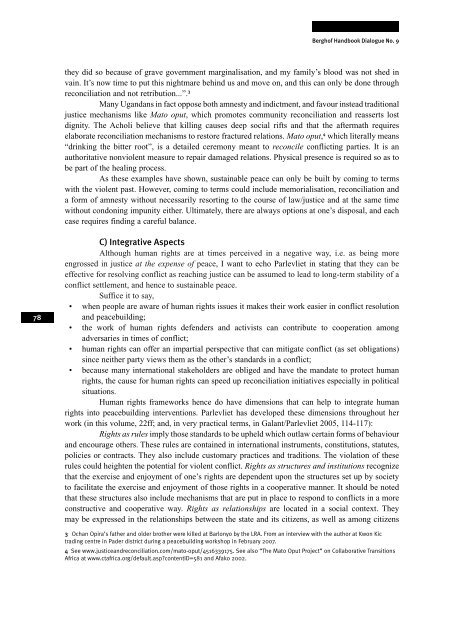Human rights and conflict transformation: The challenges of just peace
Human rights and conflict transformation: The challenges of just peace
Human rights and conflict transformation: The challenges of just peace
You also want an ePaper? Increase the reach of your titles
YUMPU automatically turns print PDFs into web optimized ePapers that Google loves.
78<br />
Bergh<strong>of</strong> H<strong>and</strong>book Dialogue No. 9<br />
they did so because <strong>of</strong> grave government marginalisation, <strong>and</strong> my family’s blood was not shed in<br />
vain. It’s now time to put this nightmare behind us <strong>and</strong> move on, <strong>and</strong> this can only be done through<br />
reconciliation <strong>and</strong> not retribution...”. 3<br />
Many Ug<strong>and</strong>ans in fact oppose both amnesty <strong>and</strong> indictment, <strong>and</strong> favour instead traditional<br />
<strong>just</strong>ice mechanisms like Mato oput, which promotes community reconciliation <strong>and</strong> reasserts lost<br />
dignity. <strong>The</strong> Acholi believe that killing causes deep social rifts <strong>and</strong> that the aftermath requires<br />
elaborate reconciliation mechanisms to restore fractured relations. Mato oput, 4 which literally means<br />
“drinking the bitter root”, is a detailed ceremony meant to reconcile <strong>conflict</strong>ing parties. It is an<br />
authoritative nonviolent measure to repair damaged relations. Physical presence is required so as to<br />
be part <strong>of</strong> the healing process.<br />
As these examples have shown, sustainable <strong>peace</strong> can only be built by coming to terms<br />
with the violent past. However, coming to terms could include memorialisation, reconciliation <strong>and</strong><br />
a form <strong>of</strong> amnesty without necessarily resorting to the course <strong>of</strong> law/<strong>just</strong>ice <strong>and</strong> at the same time<br />
without condoning impunity either. Ultimately, there are always options at one’s disposal, <strong>and</strong> each<br />
case requires finding a careful balance.<br />
C) Integrative Aspects<br />
Although human <strong>rights</strong> are at times perceived in a negative way, i.e. as being more<br />
engrossed in <strong>just</strong>ice at the expense <strong>of</strong> <strong>peace</strong>, I want to echo Parlevliet in stating that they can be<br />
effective for resolving <strong>conflict</strong> as reaching <strong>just</strong>ice can be assumed to lead to long-term stability <strong>of</strong> a<br />
<strong>conflict</strong> settlement, <strong>and</strong> hence to sustainable <strong>peace</strong>.<br />
Suffice it to say,<br />
• when people are aware <strong>of</strong> human <strong>rights</strong> issues it makes their work easier in <strong>conflict</strong> resolution<br />
<strong>and</strong> <strong>peace</strong>building;<br />
• the work <strong>of</strong> human <strong>rights</strong> defenders <strong>and</strong> activists can contribute to cooperation among<br />
adversaries in times <strong>of</strong> <strong>conflict</strong>;<br />
• human <strong>rights</strong> can <strong>of</strong>fer an impartial perspective that can mitigate <strong>conflict</strong> (as set obligations)<br />
since neither party views them as the other’s st<strong>and</strong>ards in a <strong>conflict</strong>;<br />
• because many international stakeholders are obliged <strong>and</strong> have the m<strong>and</strong>ate to protect human<br />
<strong>rights</strong>, the cause for human <strong>rights</strong> can speed up reconciliation initiatives especially in political<br />
situations.<br />
<strong>Human</strong> <strong>rights</strong> frameworks hence do have dimensions that can help to integrate human<br />
<strong>rights</strong> into <strong>peace</strong>building interventions. Parlevliet has developed these dimensions throughout her<br />
work (in this volume, 22ff; <strong>and</strong>, in very practical terms, in Galant/Parlevliet 2005, 114-117):<br />
Rights as rules imply those st<strong>and</strong>ards to be upheld which outlaw certain forms <strong>of</strong> behaviour<br />
<strong>and</strong> encourage others. <strong>The</strong>se rules are contained in international instruments, constitutions, statutes,<br />
policies or contracts. <strong>The</strong>y also include customary practices <strong>and</strong> traditions. <strong>The</strong> violation <strong>of</strong> these<br />
rules could heighten the potential for violent <strong>conflict</strong>. Rights as structures <strong>and</strong> institutions recognize<br />
that the exercise <strong>and</strong> enjoyment <strong>of</strong> one’s <strong>rights</strong> are dependent upon the structures set up by society<br />
to facilitate the exercise <strong>and</strong> enjoyment <strong>of</strong> those <strong>rights</strong> in a cooperative manner. It should be noted<br />
that these structures also include mechanisms that are put in place to respond to <strong>conflict</strong>s in a more<br />
constructive <strong>and</strong> cooperative way. Rights as relationships are located in a social context. <strong>The</strong>y<br />
may be expressed in the relationships between the state <strong>and</strong> its citizens, as well as among citizens<br />
3 Ochan Opira’s father <strong>and</strong> older brother were killed at Barlonyo by the LRA. From an interview with the author at Kwon Kic<br />
trading centre in Pader district during a <strong>peace</strong>building workshop in February 2007.<br />
4 See www.<strong>just</strong>ice<strong>and</strong>reconciliation.com/mato-oput/4516339175. See also “<strong>The</strong> Mato Oput Project” on Collaborative Transitions<br />
Africa at www.ctafrica.org/default.asp?contentID=581 <strong>and</strong> Afako 2002.

















